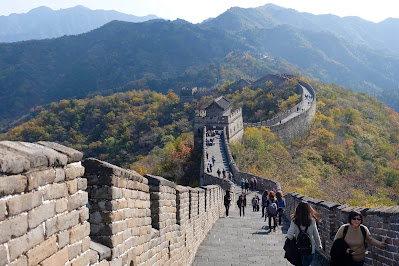When it comes to historical places in the whole world, we can assure you that there’s going to be a lot on your plate. Since the world has been alive for so long, there are many historical places out there that await you. However, of course, we only want you to see the best. Now if we’re talking about the best, nothing compares to the UNESCO heritage sites. Overall, there are 1,092 UNESCO World Heritage Sites worldwide, including 209 natural sites and 845 that are significant in both culture and history. All of these locations are acknowledged as being of international significance and deserving of special protection. With all these places, it’s harder to pick out only a few ones that indeed stand out the most. But we’ve done all the dirty work for you and have assessed the top-tier historical places in UNESCO.
Here are the best historical places to visit in the world!
1. Taj Mahal, India
Taj Mahal is a place you’ve probably heard of lots of times. It’s one of the most historic places all over the world. Its history goes back to 1632 when The Mughal emperor Shah Jahan ordered the construction of the vast Taj Mahal mausoleum complex to keep the bones of his beloved wife. The renowned complex, which was built on the southern bank of the Yamuna River in Agra, India, over the course of 20 years, is one of the best examples of Mughal architecture, which fused influences from India, Persia, and Islam. The Taj Mahal, a structure made of glistening white marble that appears to change color depending on the light, is located in the center of the complex. It was named a UNESCO World Heritage site in 1983 and continues to be one of the most renowned buildings in the world as well as a breathtaking representation of India's extensive history. Because of its beauty and historical value, it stands a place in the 7 wonders of the world!
2. Nubian Monuments, Egypt
3. Angkor Wat, Cambodia
One of the most well-known World Heritage Sites is the temple complex known as Angkor Wat, built in the 12th century. Prior to becoming a Buddhist temple, it was initially constructed as a Hindu temple. Due to the ruins' concealment by trees and other vegetation, they exude a certain air of mysticism. Angkor Wat is one of the greatest religious structures in the world, covering over 400 acres. By the end of the 12th century, Angkor Wat, which was once devoted to the Hindu god Vishnu, had converted to Buddhism. Even though it is no longer a functioning temple, it is nevertheless a popular tourist destination in Cambodia. This is despite the fact that it was severely damaged both during the Khmer Rouge regime's dictatorial control in the 1970s and earlier regional battles.
4. Machu Picchu, Peru
Machu Picchu was constructed with polished dry-stone walls in the traditional Inca manner. The Inti Watana, the Temple of the Sun, and the Room of the Three Windows are its three main buildings.
It is the most well-known representation of Inca civilization and is frequently referred to incorrectly as the "Lost City of the Incas." The estate was constructed by the Incas around 1450, but they left it unoccupied until the Spanish Conquest a century later. The majority of the distant structures have undergone reconstruction in order to better convey to visitors how they originally looked. Thirty percent of Machu Picchu had been restored by 1976, and work on restoration is ongoing. In 1981, Machu Picchu has designated a historical sanctuary by Peru, and in 1983, it was inscribed on the UNESCO World Heritage List. In a global Internet survey conducted in 2007, Machu Picchu was chosen as one of the New Seven Wonders of the World. If you’re planning to go, it is situated above the Sacred Valley, which is 80 kilometers northwest of Cuzco and through which the Urubamba River flows, in the Cusco Region, Urubamba Province, and Machupicchu District of Peru.
5. Petra, Jordan
Known for its amazing tombs and temples, Petra in Jordan has become a world-famous destination. In the third century BC, the Nabataeans cut palaces, temples, tombs, stores, and stables out of the soft stone cliffs to create the magnificent sandstone city of Petra. It doesn't require any introduction now that it is a World Heritage Site; suffice it to say that no trip to Jordan is complete without spending at least two days visiting the amazing Ancient City. It can be reached by way of the nearby town of Wadi Musa, which serves as a transportation and lodging hub. The Nabataeans, a group of master builders with expertise in hydraulic engineering, iron manufacture, and copper refining, controlled the trade routes from Damascus to Arabia from Petra and reaped the benefits of the taxes collected from caravans passing through their domain.
6. The Great Wall, China
The Great Wall of China has been featured in many movies like the Karate Kid. It has been a historical place that receives great appreciation for its exterior and, of course, its historical value. Nearly all of the Great Wall's portions were constructed on mountain ranges because of its initial use as a military fortification; hence, even the sections that have undergone extensive restoration still need some difficult climbs and uneven staircases. You can see the unrestored portion of the Great Wall if you climb to its end while visiting a section that has been restored Most tourists will find Mutianyu and Jinshanling to be excellent medium-difficulty hikes that are nevertheless extremely safe. The Jinshanling to Jinshanling East or Gubeikou to Jinshanling routes is our recommendations for people searching for a challenging hike via untamed, unrestored sections of the Wall. Both untouched and charmingly restored portions of the Wall can be found along all of these paths.







No comments:
Post a Comment